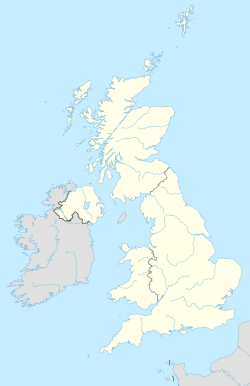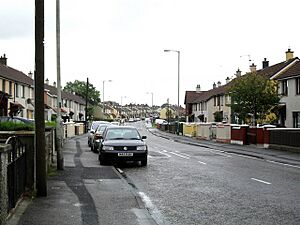Creggan, Derry facts for kids
Quick facts for kids
Creggan, Derry
An Creagán
|
|
|---|---|
|
housing estate
|
|
Creggan (which is An Creagán in Irish) means stony place. It is a large housing estate in Derry, Northern Ireland. Creggan sits on a hill not far from the River Foyle. It is built on the townlands of Ballymagowan and Edenballymore.
This area is very close to the border with County Donegal in the Republic of Ireland.
Contents
A Look Back at Creggan's History
Creggan During the Troubles
In the late 1960s, a big movement for civil rights started in Northern Ireland. This movement was very active in Derry. It led to fighting between the police, people who supported the Union (Unionists), and people who wanted a united Ireland (Nationalists). The violence began in an area called the Bogside. Soon, it spread to other parts of Derry, including Creggan.
One famous event was the Battle of the Bogside in August 1969. This fighting caused a split in the IRA, a group that wanted a united Ireland. Two new groups were formed: the Official IRA and the Provisional IRA.
In the early years, from 1969 to 1972, the Officials were more active in Creggan. They carried out attacks on the British Army. The Provisionals also had a strong campaign, including bombings in Derry City Centre.
The British government later started arresting people without trial. This was called internment. Also, civil rights protests in Derry often turned into big riots with the Royal Ulster Constabulary (RUC), which was the police force. Because of this, areas like the Bogside and Creggan became "no-go areas." This meant the British government and the RUC could not easily enter or control them. Instead, these areas were controlled by both parts of the IRA.
This situation changed in July 1972 with Operation Motorman. After this, the British government took back control of these "no-go areas" across Northern Ireland. However, this did not stop the violence in Derry. In 1972, the Officials stopped their fighting. In 1974, they fully ended their armed actions. This led to a new group called the Irish National Liberation Army (INLA) being formed in December 1974.
After 1972, the British Army carried out large operations in the areas that were once "no-go." This caused more open clashes between the British Army, the people of Creggan, and other parts of Derry. This fighting continued until the early 1990s.
Creggan Today: Changes and Growth
Creggan has changed a lot since those times. The "no-go areas" are long gone, and the unfairness from the 1960s to 1980s has greatly reduced. The area has seen many improvements.
For example, Bishop's Field has been rebuilt into a modern sports and recreation area. A new play park has been added for children. Also, a country park and a fishing spot have been created at the old reservoir sites near the edge of the estate.
New homes have also been built on the edge of Creggan. The biggest new area is called Ballymagowan.
On April 18, 2019, a journalist named Lyra McKee was sadly shot and killed during a riot in Fanad Drive. Police believed the New IRA was responsible. The New IRA later said they were responsible and apologized.
Schools in Creggan
Primary Schools
- Holy Child Primary School
- St John's Primary School
Secondary Schools
- St Cecilia's College
- St Joseph's Boys' School
- St. Mary's Girls School
- St. Peter's High School (this school closed in 2013)
- Lumen Christi College
Fun Places to Visit in Creggan
- City Cemetery – This is Derry's largest graveyard. It opened in 1853. The cemetery has graves for 194 soldiers who died in the First World War and Second World War.
- Creggan Country Park – A fun recreation center where you can do activities.
- Bishop's Field – This is a sports pitch with an Astro-Turf surface, great for playing games.
Famous People from Creggan
- Tony O'Doherty – An international football player. He used to play for and manage Derry City F.C..
- Mickey Bradley – The bass guitarist for the band The Undertones.
- Liam Ball – An Irish Olympic swimmer.
- Dana – A pop star who was Ireland's first winner of the Eurovision song contest. She also became a politician.
- Michael Devine – One of the people who took part in the 1981 hunger strike.
- Don Mullan – A well-known author.
- Charlie Nash – A famous boxer.
- Raymond Gilmour – An informer who worked with the Royal Ulster Constabulary (RUC).
- Terry Harkin – An international football player.
- James McClean – A professional football player who plays for Wrexham A.F.C..
- Darren Kelly – A former professional football player and manager.
Creggan's Population Facts
Derry has two areas called Creggan: Creggan Central and Creggan South. There is also a smaller area called 'Beechwood' in part of lower Creggan.
The Northern Ireland Statistics and Research Agency (NISRA) says Creggan Central and South are part of the Derry Urban Area. On April 29, 2001, a census showed:
- 3,504 people lived in Creggan Central.
- 2,453 people lived in Creggan South.
Here are some details about Creggan Central:
- About 34% of people were under 16 years old.
- About 9% were 90 years old or older.
- About 46.5% of the people were male, and 53.5% were female.
- Almost 99% of people were from a Catholic background.
- About 12.5% of people aged 16 to 74 were unemployed.
And for Creggan South:
- About 30% of people were under 16 years old.
- About 15.6% were 60 years old or older.
- About 45.6% of the people were male, and 54.4% were female.
- Almost 99% of people were from a Catholic background.
- About 10% of people aged 16 to 74 were unemployed.
Understanding Creggan's Community Needs
In 2005, a study called the Northern Ireland Multiple Deprivation Measure (NIMDM) looked at 582 areas in Northern Ireland. It found that Creggan Central was the 11th most in need, and Creggan South was the 15th most in need. This study helps understand where communities might need more support.
See also
 In Spanish: Creggan para niños
In Spanish: Creggan para niños



